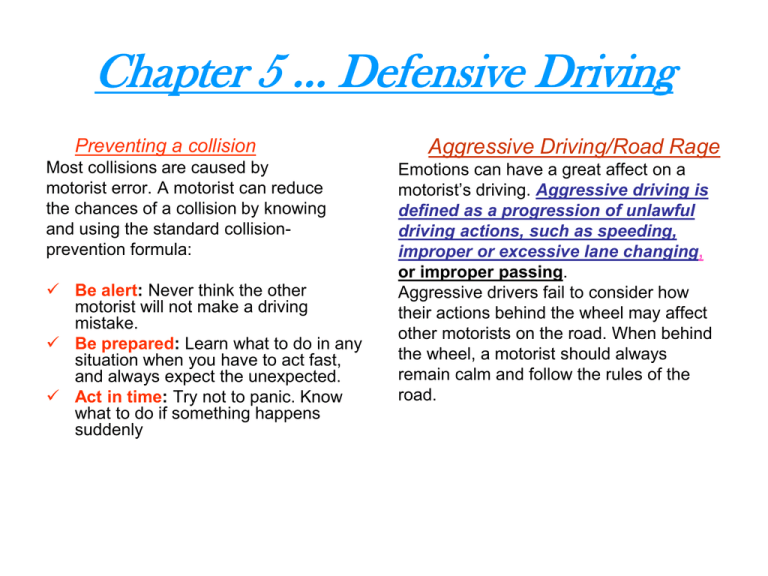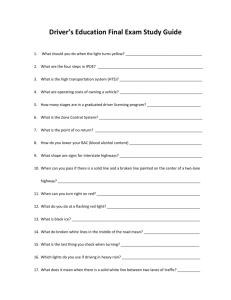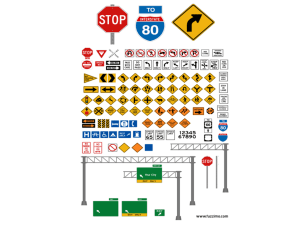Defensive Driving Guide: Collision Prevention & Safety Tips
advertisement

Chapter 5 … Defensive Driving Preventing a collision Most collisions are caused by motorist error. A motorist can reduce the chances of a collision by knowing and using the standard collisionprevention formula: Be alert: Never think the other motorist will not make a driving mistake. Be prepared: Learn what to do in any situation when you have to act fast, and always expect the unexpected. Act in time: Try not to panic. Know what to do if something happens suddenly Aggressive Driving/Road Rage Emotions can have a great affect on a motorist’s driving. Aggressive driving is defined as a progression of unlawful driving actions, such as speeding, improper or excessive lane changing, or improper passing. Aggressive drivers fail to consider how their actions behind the wheel may affect other motorists on the road. When behind the wheel, a motorist should always remain calm and follow the rules of the road. Causes for a Vehicle to Skid – Accelerate too quickly – Turn too fast – Brake too hard Vehicle Runs off Pavement • Slow down • Regain control • Ease back onto the road Driving Techniques to Avoid a Collision -Stop -Speed Up -Turn Ways to Avoid Hydroplaning • Slow down • Avoid bad Tires • Drive on highest point of road Recover from a Skid • • • • Grip wheel No gas No brake Turn into the skid Recover from a Tire Blowout • • • • • Grip wheel No brake No gas Keep straight Ease off road Involved in an accident? • • • • • Expect worst Remain calm Call for help Alert traffic Ask for assistance Driving Distractions and Highway Hypnosis In many cases, collisions are caused by a distracted motorist. Inattentive motorists often tailgate, go too fast or drift out of their lanes. They ignore traffic signs and signals, road markings, potential traffic hazards, road conditions and other vehicles. Some causes of inattentive driving are: Lighting a cigarette Trying to fasten a safety belt while driving Reaching across the seat to close a door or look in the glove compartment Reaching for coins in pockets while driving up to a toll booth Watching children or pets in the vehicle Trying to remove a coat Reading maps and newspapers Eating while driving Adjusting a mirror while driving Using a cellular phone or any other electronic device Adjusting the radio or CD player Shaving Using a computer Applying make-up “Trance-Like State” A tired driver can be as dangerous as a drunk driver. Maggie’s Law, which was enacted in June 2003, makes it illegal to knowingly drive a vehicle while impaired by lack of sleep. This law establishes driving while fatigued as recklessness under the vehicular homicide statute You can help prevent highway hypnosis by following a few simple rules: Don't eat a heavy meal before you drive. Wear comfortable clothing. Talk with your passengers, but not to the point of distraction. Keep your eyes moving and check your mirrors often. Take an interest in all road signs and traffic around you. Take a coffee or walking break every hour. Don't try to drive too far in one day. Avoid driving during your normal sleeping hours. Keep the temperature in your vehicle cool. 3 Second Rule of Following Distance Choose some fixed object ahead of the vehicle in front. The object may be a sign or a tree. Make sure the object does not distract attention from driving As the vehicle in front passes the object, begin counting seconds (one thousand- one, one-thousand-two, one thousand three). If it takes at least three seconds before your vehicle passes the object, a motorist should have enough distance for a sudden stop Following Distance Keep a Safe Distance / Do Not Tailgate Although there is no perfect rule for following distance, the rule of thumb most often used is to keep one car length back (about 20 feet) for each 10 miles per hour of speed. Tailgating refers to following too closely behind a vehicle directly in front. Rear-End collisions are the most common type of accident as a result of tailgating. Road Conditions 20 mph 30 mph 40 mph 50 mph Ideal 2 Car Lengths 3 4 5 Wet Pavement 4 Car Lengths 6 8 10 Gravel 4 Car Lengths 6 8 10 Packed Snow 6 Car Lengths 9 12 Ice 12 Car Lengths 18 24 15 30 Hydroplaning Wet road surfaces can cause tires to hydroplane, or Ride up on a film of water, starting at about 35 mph, which could cause a motorist to lose control of his/her vehicle. Chances of hydroplaning increase as speeds increase. After 55 mph, tires may totally leave the road surface. If tires totally leave the road surface, braking is virtually impossible, and turning is not possible. To avoid hydroplaning, do not drive on bald or badly worn tires, and slow down when heavy rain, standing water or slush is present Occurs within the first few minutes of rainfall. When driving through a water puddle, a motorist should test the brakes by pumping them. This will also help to dry the brakes. City & Highway Driving City Driving Highway Driving When traveling in a city, heavier traffic and more pedestrians require motorists to be very alert. Drive more slowly and watch for the movements of others. Motorists must be more careful about pedestrians and less-visible vehicles, such as bicycles, motorcycles. Motorists must always stop for pedestrians in a crosswalk. Traffic accidents and deaths can happen on highways when the weather is good and the roads are dry. Exceeding the posted speed limit or driving too fast for road conditions is one of the most prevalent factors contributing to traffic collisions. Major highways are usually in good condition. They often have four or more lanes. It is important to stay alert and drive defensively. Always be ready to react to the unexpected. A motorist should look at least 12 seconds ahead. This means that you should be able to see an object far enough ahead so that it takes at least 12 seconds to get to it. While driving at 25 mph on a clear road in a city, a motorist should be able to see about a block ahead. When traffic is heavy, extra time to react is necessary, which means driving more slowly. By reducing speed, a motorist gains time. Tips for City Driving • If at the middle of a block, check intersections ahead for traffic controls. • When approaching the intersection, reduce speed. Glance left and then right. Be prepared to brake. • When at a crosswalk, a vehicle should be at its lowest speed. A motorist must decide whether to stop or go across. Passing Changing Lanes and Passing Using the proper lane is an important part of defensive driving. Be alert to traffic behind. When a lane change must be made, look at the rearview mirror. Glance behind to check blind spots. Always signal lane changes. Before passing a vehicle or changing lanes, keep the following points in mind: Only pass or change lanes when necessary. Only pass or change lanes if it can be completed without speeding. Keep a safe following distance; do not tailgate. Check traffic ahead and behind. Only pass when signs and pavement markings permit. Signal every lane change. Signal your return to the right lane. Return to the right lane when well ahead of the vehicle that was passed. (A good indication that it is safe to return to the right lane is when the vehicle that was passed is visible in the rearview mirror.) Cancel the turn signal. Being Passed by Another Vehicle When a motorist is passed by another vehicle, stay in the proper lane and slow down to make the pass easier for the other motorist. Return to normal speed after the passing vehicle is well ahead Space Cushion- Maintaining a safe distance around the vehicle to help avoid collisions High Beams Used for open country driving Not to be used in fog Construction Zones Fines are doubled Designated by orange signs and/or flashing lights Gas Pedal Sticks Shift to neutral Apply Brakes How Do Drivers Communicate? 1. 2. 3. 4. Horn Headlights Turn/hand signals Eye Contact




